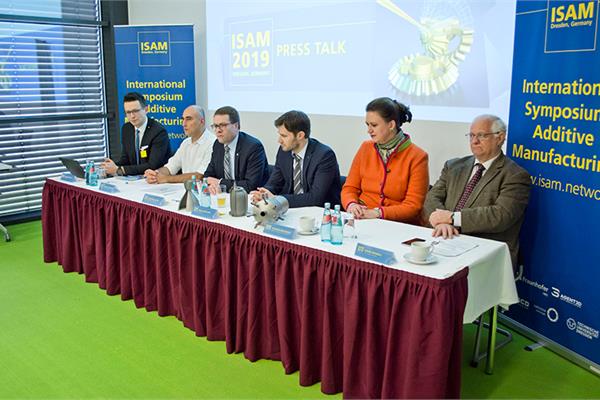
Cost-efficiency, new materials and structures: additive manufacturing sets fresh impulses to production and enables new processes and applications in traditional industries.
From 29 till 31 January 2019 about 300 international experts meet in Dresden (Germany) for the 3rd International Symposium Additive Manufacturing (ISAM 2019) to discuss the development and future perspectives of additive manufacturing in application industries. "The venue is definitely not a coincidence", says Prof. Christoph Leyens, Director of the hosting Fraunhofer Institute for Material and Beam Technology IWS and Director of the institute for Materials Science at TU Dresden, one of the German Universities of Excellence. "Dresden is one of Europe's leading research and innovation sites for industrial applications: At the Fraunhofer IWS-led innovation consortium AGENT-3D alone more than 120 partners from industry and science jointly work at the advancement of additive manufacturing processes, also known as 3D printing. Together they are shaping the evolution of production processes and launching a new printing age", Prof. Leyens adds.
Additive Manufacturing: Tool-less, cost-efficient, fast and on point
Additive Manufacturing, in which materials are layered in order to "print" a product, tool, or prototype, is already being used in various traditional industries such as rail technology but also in manufacturing sectors. With this process, wear parts can be produced cost-efficiently and quickly even in small batches making them immediately available for maintenance and repair work. All needed for production is a computer model that is replacing the traditional, more expensive mold. The layering principle allows any complex geometry or inner structure and offers almost unlimited freedom in design and construction when handling materials. This did not go unnoticed by the aerospace industry: It uses these production processes to build prototypes of a new design that make air- and spacecrafts lighter, more flexible and more cost-efficient, Dr. Laurent Pambaguian of the European Space Agency said at the symposium. Today additive manufacturing is mostly using materials such as plastics, ceramics, synthetic resin or metal. Composites like carbon fibre composites or nanomaterials have recently gained in importance. In addition to guaranteeing specific product characteristics the integration of new functionalities into the component is a key objective of modern material sciences.
From niche technology to disruptive power
Additive Manufacturing has been in the industry analyst's eye for a long time already: The market is growing rapidly, in 2017 it reached about seven billion dollars. More and more companies seek and find their place in the value chain1. Especially additive manufacturing using metals is already making the leap from a niche technology to industrial maturity2. "Additive Manufacturing brings new momentum to production and shakes through traditional industries and markets", says Prof. Leyens. Fraunhofer IWS supports established players on their way to the future. The researchers are focusing on using different materials in one component, scaling component dimensions and topologically optimizing structures. "Our partners from the aerospace industry, tool manufacturing or medical technology benefit from our unique infrastructure", Prof. Leyens adds. "We offer a wide process variety in additive manufacturing, our own industry-proved, technological systems development and supporting systems for non-destructive testing."
ISAM 2019: Experts for the next technology leap
At this year's ISAM international experts from science and industry discuss new applications of additive manufacturing in industrial environment. In her speech "We Print to Drive: Mobility goes Additive" Stefanie Brickwede of Deutschen Bahn AG explains, which solutions additive manufacturing offers for mobility and Chang-Woo Lee of KITECH shows in "Metal Additive Manufacturing Process Technology of Medical Applications in South Korea", how medical technology benefits from printing processes. Prof. Frank Brueckner, head of the Additive Manufacturing unit at IWS and coordinator of the Additive Manufacturing Center Dresden (AMCD), which offers tool and process solutions for aerospace, automotive, energy, tool and mold engineering as well as medical technology, knows: "Those are examples for the technology's manifold application possibilities. The more reliable the processes become, the more stable the components and the more flexible their application even in wear-critical applications. China is already printing whole houses."
The European focus is more on the application in industrial production. For these fields one also requires new materials and material mixes that can meet the increasing challenges of flexibility and stability. At the same time, costs cannot be ignored. "In the end, process quality and productivity are the linchpins for the rung in triumph of additive manufacturing – that is what international researchers put all their know-how in for. We are happy that IWS and AMCD play a major role in the development of additive manufacturing", Prof. Leyens concludes.